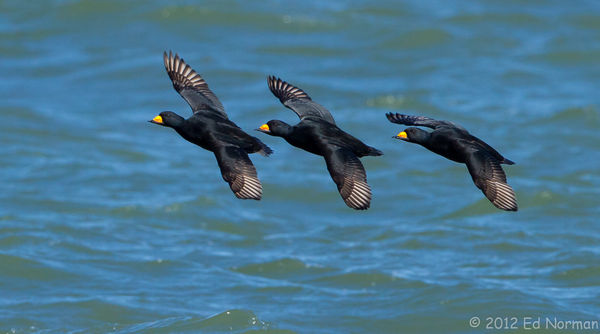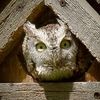Using a Tripod for Birds in Flight
This topic is locked to prevent further replies.
Feb 24, 2013 20:59:39 #
Although I am a proponent for handholding your camera for Birds in Flight, there are times when a good sturdy tripod is either very helpful or a downright necessity.
Personally, I can handhold my 500mm f/4 lens for short periods, but if I dont need to move around too much or if I will be required to hold it up for any length of time, or Im in a blind, I will resort to a tripod. If I am using my 1.4 Tele-converter, I almost always use a tripod or, at the least, prop it up on something stable. Because a tripod can also let you shoot at lower shutter durations than you can handheld, it can be a great help in lower light conditions.
I will also break out the tripod when I know the birds will be on a regular, predictable flight path. An example would be when I am on a jetty by an inlet. When the tide is running out the birds will be swept out to sea by the current, fishing and feeding as they are pushed along. When those birds reach the open ocean, they fly back up the inlet, parallel to the jetty. When they get far enough in they drop back into the water for another trip out to sea. This repeating pattern gives you numerous chances to photograph the birds as they pass you by. You might also know of a pond that the ducks fly in to every afternoon, always into the wind. A flock of terns that are feeding on a school of fish will often follow a flight pattern where they fly into the wind, plunge into the water to catch the fish and then fly downwind only to turn into the wind again for another pass. They fly into the wind and match their forward speed to the wind speed resulting in little or no ground speed. That is an ideal time for great flight shots.
Make sure you have a sturdy tripod that can carry the weight of your biggest lens/body combination. Manufacturers websites will state what weight or size lens is appropriate. This is not the time to cheep out! For lenses 400mm and below a standard head or large ball head will suffice* but at 500 mm+ a gimbal head becomes necessary. My Canon 500mm f/4 and 7D body weighs about 9 pounds. With a gimbal head the weight is suspended and gravity works with you. If the lens/body combo is balanced it will stay where it is if you take your hand off the camera and you dont need to tighten the knobs. With a standard head, everything depends on friction and gravity works against you. Its a sickening feeling to see your camera/lens tip over if you didnt tighten the knobs enough. Carbon fiber is a benefit if you carry your gear in the field and or work in a salt water environment. If you work in cold weather, an aluminum tripod will suck the heat out of even a gloved hand.
I set my tripod up so that I am standing on the baseline of the triangle formed by the legs. Since the tripod column is the pivot point around which I have to walk, I dont want a tripod leg in between my feet. If you have to pan far enough, the tripod legs, inevitably, get in the way, so try always to set up with your feet on the base of the triangle so you will know where the leg is. I adjust the tripod height so that I can depress the lens comfortably without standing on my tip toes. My right hand is on the camera body at the controls and my left hand is along the lens barrel. I find that helps me get the lens on target by giving me feed back as to where the lens is pointed. Feedback I dont get just from my right hand.
It is generally recommended to turn off image stabilization as it can actually introduce vibration in a lens that is perfectly still. Some lenses now are tripod aware and you dont have to worry about it. The one time I find stabilization to be of benefit with a tripod is if I am being buffeted by the wind, then it has great value. This reminds me that, if it is windy you should anchor or tie down your tripod. Many tripods have a convenient hook under the column just for this purpose.
Anticipate where the birds are coming from and try to pick them up even if they are a little far away. Begin tracking them and then initiate autofocus using either a half press of the shutter button or back button AF. When you have focus, gently squeeze the shutter button and begin taking pictures all the while tracking the bird as it flies past you. After it has begun to move away from you, stop taking pictures but continue to track the bird in order to maintain a smooth panning motion. We are pivoting around the tripod so begin by taking a shoulder width stance and then move around the tripod by stepping with your forward leg first. In other words, dont cross your legs when you step, if you are moving to the right, step with the right foot first.
Most of all, practice, practice, practice!
*A 300mm f/2.8 at 6 lbs and a 400mm f/2.8 at 8 lbs are candidates for a gimbal head also.
Personally, I can handhold my 500mm f/4 lens for short periods, but if I dont need to move around too much or if I will be required to hold it up for any length of time, or Im in a blind, I will resort to a tripod. If I am using my 1.4 Tele-converter, I almost always use a tripod or, at the least, prop it up on something stable. Because a tripod can also let you shoot at lower shutter durations than you can handheld, it can be a great help in lower light conditions.
I will also break out the tripod when I know the birds will be on a regular, predictable flight path. An example would be when I am on a jetty by an inlet. When the tide is running out the birds will be swept out to sea by the current, fishing and feeding as they are pushed along. When those birds reach the open ocean, they fly back up the inlet, parallel to the jetty. When they get far enough in they drop back into the water for another trip out to sea. This repeating pattern gives you numerous chances to photograph the birds as they pass you by. You might also know of a pond that the ducks fly in to every afternoon, always into the wind. A flock of terns that are feeding on a school of fish will often follow a flight pattern where they fly into the wind, plunge into the water to catch the fish and then fly downwind only to turn into the wind again for another pass. They fly into the wind and match their forward speed to the wind speed resulting in little or no ground speed. That is an ideal time for great flight shots.
Make sure you have a sturdy tripod that can carry the weight of your biggest lens/body combination. Manufacturers websites will state what weight or size lens is appropriate. This is not the time to cheep out! For lenses 400mm and below a standard head or large ball head will suffice* but at 500 mm+ a gimbal head becomes necessary. My Canon 500mm f/4 and 7D body weighs about 9 pounds. With a gimbal head the weight is suspended and gravity works with you. If the lens/body combo is balanced it will stay where it is if you take your hand off the camera and you dont need to tighten the knobs. With a standard head, everything depends on friction and gravity works against you. Its a sickening feeling to see your camera/lens tip over if you didnt tighten the knobs enough. Carbon fiber is a benefit if you carry your gear in the field and or work in a salt water environment. If you work in cold weather, an aluminum tripod will suck the heat out of even a gloved hand.
I set my tripod up so that I am standing on the baseline of the triangle formed by the legs. Since the tripod column is the pivot point around which I have to walk, I dont want a tripod leg in between my feet. If you have to pan far enough, the tripod legs, inevitably, get in the way, so try always to set up with your feet on the base of the triangle so you will know where the leg is. I adjust the tripod height so that I can depress the lens comfortably without standing on my tip toes. My right hand is on the camera body at the controls and my left hand is along the lens barrel. I find that helps me get the lens on target by giving me feed back as to where the lens is pointed. Feedback I dont get just from my right hand.
It is generally recommended to turn off image stabilization as it can actually introduce vibration in a lens that is perfectly still. Some lenses now are tripod aware and you dont have to worry about it. The one time I find stabilization to be of benefit with a tripod is if I am being buffeted by the wind, then it has great value. This reminds me that, if it is windy you should anchor or tie down your tripod. Many tripods have a convenient hook under the column just for this purpose.
Anticipate where the birds are coming from and try to pick them up even if they are a little far away. Begin tracking them and then initiate autofocus using either a half press of the shutter button or back button AF. When you have focus, gently squeeze the shutter button and begin taking pictures all the while tracking the bird as it flies past you. After it has begun to move away from you, stop taking pictures but continue to track the bird in order to maintain a smooth panning motion. We are pivoting around the tripod so begin by taking a shoulder width stance and then move around the tripod by stepping with your forward leg first. In other words, dont cross your legs when you step, if you are moving to the right, step with the right foot first.
Most of all, practice, practice, practice!
*A 300mm f/2.8 at 6 lbs and a 400mm f/2.8 at 8 lbs are candidates for a gimbal head also.
A trio of Black Scoters at Barnegat Inlet jetty...using a tripod.

If you want to reply, then register here. Registration is free and your account is created instantly, so you can post right away.
